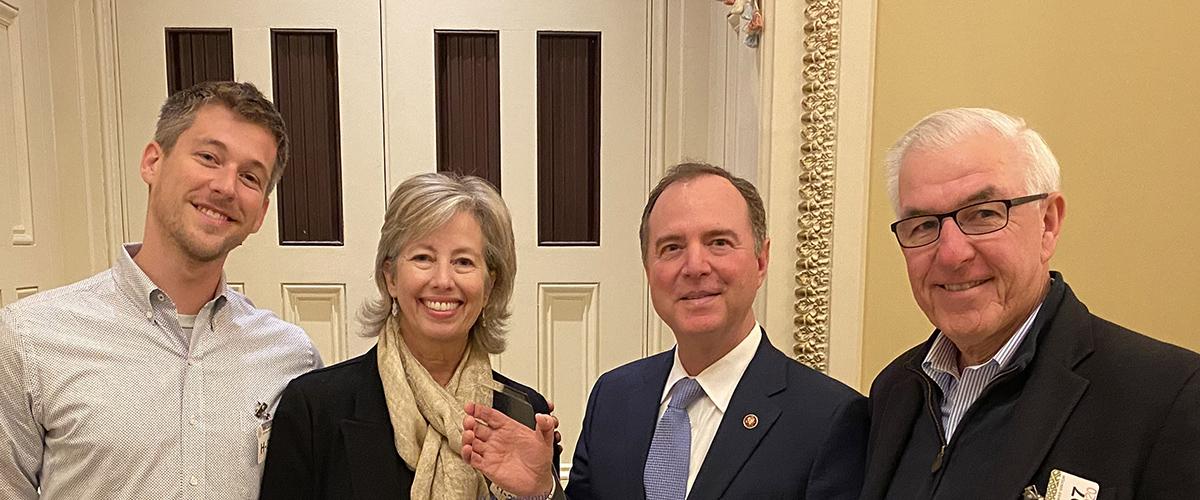Small Molecule Approaches to DM1
A variety of small molecules have been evaluated in models of DM1 as putative therapeutics. Small molecules have the advantage of chemical optimization of drug-like traits, including blood-brain barrier permeability, and thus are attractive for multisystemic disorders like DM1.
Prior studies of the small molecule, pentamidine, and its analogs showed efficacy in restoring splicing defects in DM1 cells and animal models and suggested that the mechanism of action was binding to and inhibition of transcription of the expanded repeat transcript (Coonrod et al., 2013). Chemical modification/analysis of structure-activity relationships of the pentamidine backbone led to identification of the more efficacious and less toxic molecule, furamidine (Siboni et al., 2015).
In evaluation of compounds for marketing approval, FDA and other regulatory agencies regard understanding of the molecular target and mechanism of action as important factors in establishing confidence in the efficacy and safety of candidate therapeutics. Thus, mechanistic studies, using cell and animal models in preclinical studies and molecular markers in clinical trials, represent important steps in evaluation of candidate therapeutics for DM.
Mechanism of Action of Furamidine
Dr. Andy Berglund (University of Florida) and colleagues have built upon their prior work with pentamidine analogs to examine the mechanisms of action (MOA) of furamidine in DM1 models (Jenquin et al., 2018). Dr. Leslie Coonrod, a former MDF Postdoctoral Fellow, was a coauthor on the publication. Information on the structure, properties, vendors, publications, and patents around furamidine is available in the public chemical database, PubChem. Overall the research team reported promiscuous activity for furamidine, potentially impacting multiple pathways in restoring the splicopathy that characterizes DM1.
Furamidine was evaluated in HSALR mice for safety and impact upon gene expression and splicing and in DM1 myotubes for safety and impact on splicing. Head to head comparisons were made with another pentamidine analog, heptamidine.
In the HSALR model, furamidine (daily, over 7 days) reduced HSA transgene levels and rescued multiple splicing events, suggesting binding of CTG•CAG expanded repeats and transcription inhibition as an important MOA for the drug. In comparison to heptamidine, furamidine rescued more splicing events in the mouse model. Evaluation of furamidine in a patient myoblast line (~2900 repeats) also showed partial rescue of the characteristic mis-splicing pattern. Although dose-limiting toxicity was seen in the cell line studies, efficacy on splicing was obtain at 10x and greater multiples below toxic dose—this was confirmed in follow-up cell toxicity assays. However, in the cell-based assays and in contrast to the HSALR data, the impact of the drug on CUG RNA levels was modest.
In additional studies with the human DM1 cell lines, data suggest that furamidine reduces nuclear foci and disrupts the binding of MBNL1 to expanded CUG repeats. Yet, at higher concentrations, furamidine exacerbated mis-splicing while producing a significant reduction in nuclear foci—a finding that the research team first interpreted as drug-induced reduction of MBNL levels; this hypothesis was not confirmed as transcript and protein levels were increased by furamidine treatment.
Assessing a Complex MOA
Taken together, furamidine exhibited a complex MOA, with both similar and discordant findings in cell vs. animal models and across a 100-fold dosing range studied by the research team. They conclude that its primary MOA in the HSALR mouse appears to be inhibition of transcription of the expanded repeat, but cannot exclude disruption of MBNL from expanded CUG repeat binding. By contrast, the team posits that increased levels of MBNL proteins and furamidine-induced disruption of the MBNL–CUG complex represent the primary MOA for splicing rescue in patient cell lines. Differences in the pathways engaged by the effective drug concentrations at the target tissues (i.e., tissue bioavailability/exposure) may, at least in part, explain differences in MOA findings in the two models.
Reference:
Reducing levels of toxic RNA with small molecules.
Coonrod LA, Nakamori M, Wang W, Carrell S, Hilton CL, Bodner MJ, Siboni RB, Docter AG, Haley MM, Thornton CA, Berglund JA.
ACS Chem Biol. 2013 Nov 15;8(11):2528-37. doi: 10.1021/cb400431f. Epub 2013 Sep 27.
Biological Efficacy and Toxicity of Diamidines in Myotonic Dystrophy Type 1 Models.
Siboni RB, Bodner MJ, Khalifa MM, Docter AG, Choi JY, Nakamori M, Haley MM, Berglund JA.
J Med Chem. 2015 Aug 13;58(15):5770-80. doi: 10.1021/acs.jmedchem.5b00356. Epub 2015 Jul 21.
Furamidine rescues myotonic dystrophy type I associated mis-splicing through multiple mechanisms.
Jenquin JR, Coonrod LA, Silverglate QA, Pellitier NA, Hale MA, Xia G, Nakamori M, Berglund JA.
ACS Chem Biol. 2018 Aug 17. doi: 10.1021/acschembio.8b00646. [Epub ahead of print]

